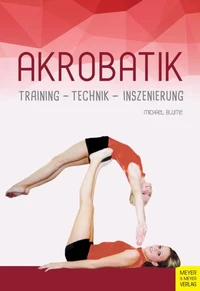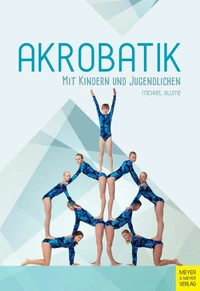Acrobatics for Children & Teenagers
Par :Formats :
Disponible dans votre compte client Decitre ou Furet du Nord dès validation de votre commande. Le format ePub est :
- Compatible avec une lecture sur My Vivlio (smartphone, tablette, ordinateur)
- Compatible avec une lecture sur liseuses Vivlio
- Pour les liseuses autres que Vivlio, vous devez utiliser le logiciel Adobe Digital Edition. Non compatible avec la lecture sur les liseuses Kindle, Remarkable et Sony
 , qui est-ce ?
, qui est-ce ?Notre partenaire de plateforme de lecture numérique où vous retrouverez l'ensemble de vos ebooks gratuitement
Pour en savoir plus sur nos ebooks, consultez notre aide en ligne ici
- Nombre de pages180
- FormatePub
- ISBN978-1-78255-350-2
- EAN9781782553502
- Date de parution01/12/2013
- Protection num.Digital Watermarking
- Taille13 Mo
- Infos supplémentairesepub
- ÉditeurMEYER + MEYER FACHVERLAG
Résumé
Children and teenagers find acrobatics exciting. The challenge of risking their equilibrium together and building human formations is intriguing. Team spirit and the willingness to cooperate are required. Many of the spectacular human pyramids and partner balances are easy to learn and considerable progress can be made in a short period of time.
This book provides a vivid and informative description of the principles of partner acrobatics with children and teenagers.
It provides suggestions on how to begin and how to design meaningful training sessions, as well as different options for the structuring of performances. In addition to the many preparatory exercises, the practical portion of the book introduces simple acrobatic formations that have been tried and tested. The individual chapters include detailed written and visual descriptions of the many different techniques, from pyramid building to fantasy formations, from dynamic elements to elegant partner formations. The Evolution of Acrobatics Acrobatics is considered a movement art with a long tradition and evolutionary history.
The term "acrobatics" stems from the Greek word "akrobates", which actually means, "one walking on his toes" and originally referred to a tightrope walker. The oldest testimonials on acrobatics (approximately 2000 BC) were found in Egypt and consist primarily of drawings on limestone rocks. The first written evidence stems from an account of an Egyptian feast in the 4th century BC, during which acrobats performed and built tall human pyramids. Acrobats have always been on the fringes of society, were seen as infamous and as a "vagrant people" who remained without rights. Their circumstances changed little during the Middle Ages.
Only the emergence of the circus at the end of the 18th and beginning of the 19th century represented a definitive turning point for travelling artists and acrobats.
It provides suggestions on how to begin and how to design meaningful training sessions, as well as different options for the structuring of performances. In addition to the many preparatory exercises, the practical portion of the book introduces simple acrobatic formations that have been tried and tested. The individual chapters include detailed written and visual descriptions of the many different techniques, from pyramid building to fantasy formations, from dynamic elements to elegant partner formations. The Evolution of Acrobatics Acrobatics is considered a movement art with a long tradition and evolutionary history.
The term "acrobatics" stems from the Greek word "akrobates", which actually means, "one walking on his toes" and originally referred to a tightrope walker. The oldest testimonials on acrobatics (approximately 2000 BC) were found in Egypt and consist primarily of drawings on limestone rocks. The first written evidence stems from an account of an Egyptian feast in the 4th century BC, during which acrobats performed and built tall human pyramids. Acrobats have always been on the fringes of society, were seen as infamous and as a "vagrant people" who remained without rights. Their circumstances changed little during the Middle Ages.
Only the emergence of the circus at the end of the 18th and beginning of the 19th century represented a definitive turning point for travelling artists and acrobats.
Children and teenagers find acrobatics exciting. The challenge of risking their equilibrium together and building human formations is intriguing. Team spirit and the willingness to cooperate are required. Many of the spectacular human pyramids and partner balances are easy to learn and considerable progress can be made in a short period of time.
This book provides a vivid and informative description of the principles of partner acrobatics with children and teenagers.
It provides suggestions on how to begin and how to design meaningful training sessions, as well as different options for the structuring of performances. In addition to the many preparatory exercises, the practical portion of the book introduces simple acrobatic formations that have been tried and tested. The individual chapters include detailed written and visual descriptions of the many different techniques, from pyramid building to fantasy formations, from dynamic elements to elegant partner formations. The Evolution of Acrobatics Acrobatics is considered a movement art with a long tradition and evolutionary history.
The term "acrobatics" stems from the Greek word "akrobates", which actually means, "one walking on his toes" and originally referred to a tightrope walker. The oldest testimonials on acrobatics (approximately 2000 BC) were found in Egypt and consist primarily of drawings on limestone rocks. The first written evidence stems from an account of an Egyptian feast in the 4th century BC, during which acrobats performed and built tall human pyramids. Acrobats have always been on the fringes of society, were seen as infamous and as a "vagrant people" who remained without rights. Their circumstances changed little during the Middle Ages.
Only the emergence of the circus at the end of the 18th and beginning of the 19th century represented a definitive turning point for travelling artists and acrobats.
It provides suggestions on how to begin and how to design meaningful training sessions, as well as different options for the structuring of performances. In addition to the many preparatory exercises, the practical portion of the book introduces simple acrobatic formations that have been tried and tested. The individual chapters include detailed written and visual descriptions of the many different techniques, from pyramid building to fantasy formations, from dynamic elements to elegant partner formations. The Evolution of Acrobatics Acrobatics is considered a movement art with a long tradition and evolutionary history.
The term "acrobatics" stems from the Greek word "akrobates", which actually means, "one walking on his toes" and originally referred to a tightrope walker. The oldest testimonials on acrobatics (approximately 2000 BC) were found in Egypt and consist primarily of drawings on limestone rocks. The first written evidence stems from an account of an Egyptian feast in the 4th century BC, during which acrobats performed and built tall human pyramids. Acrobats have always been on the fringes of society, were seen as infamous and as a "vagrant people" who remained without rights. Their circumstances changed little during the Middle Ages.
Only the emergence of the circus at the end of the 18th and beginning of the 19th century represented a definitive turning point for travelling artists and acrobats.








